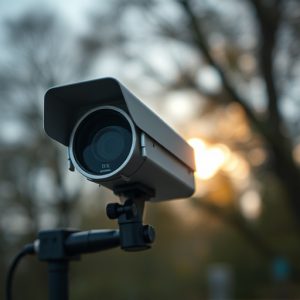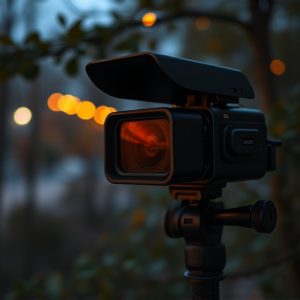Uncovering Secrets: Motion-Activated Cameras, Battery Life, & Scanning Techniques
Motion-activated spy cameras are popular for security due to their energy-efficient design, extendin…….
Motion-activated spy cameras are popular for security due to their energy-efficient design, extending battery life by activating only when motion is detected. They use light, heat, or sound sensors to capture video or still images, which can be stored locally or transmitted to a smartphone or cloud service. This feature makes them versatile for both home security and wildlife observation, providing peace of mind and valuable data. With advanced signal scanning techniques, these cameras offer discreet remote surveillance without alerting subjects. However, their extended battery life also raises ethical and legal concerns regarding privacy and data protection, emphasizing the need for responsible usage and compliance with regulations.
Hidden recording devices, often disguised as everyday items, have evolved with advanced features like motion-activated spy cameras. Understanding these devices’ functionality is crucial, especially their reliance on battery life for continuous operation. This article delves into the intricacies of hidden recording, exploring signal scanning methods to detect such devices. We discuss the importance of long-lasting batteries and ethical considerations surrounding their use, providing insights into navigating this complex landscape.
- Understanding Motion-Activated Spy Cameras and Their Functionality
- The Importance of Battery Life in Hidden Recording Devices
- Advanced Signal Scanning Techniques for Uncovering Hidden Cameras
- Ethical Considerations and Legal Implications of Using Hidden Recording Devices
Understanding Motion-Activated Spy Cameras and Their Functionality
Motion-activated spy cameras, a popular choice for home security and surveillance, operate on a simple yet effective principle: detecting motion and responding accordingly. These devices are designed to remain in a low-power state until they sense movement, at which point they swiftly capture video or still images. This functionality is particularly advantageous for conserving the Motion Activated Spy Camera Battery Life, ensuring the device remains operational for extended periods without frequent recharging.
The motion detection mechanism typically involves sensitive sensors that can pick up on changes in light, heat, or sound patterns. When triggered, the camera captures footage and stores it locally or transmits it to a connected smartphone or cloud service. This real-time monitoring capability makes them ideal for various applications, from home security to wildlife observation, offering users peace of mind and valuable visual data.
The Importance of Battery Life in Hidden Recording Devices
In the realm of hidden recording devices, particularly motion-activated spy cameras, battery life plays a pivotal role in their effectiveness and longevity. These compact surveillance tools are designed to operate discreetly, often in hard-to-reach or remote locations, making reliable power sources indispensable. A camera with an extended battery life ensures uninterrupted monitoring, capturing crucial evidence without the need for frequent recharging or replacement.
This is especially important when deploying hidden recording devices in environments where accessing power outlets might be challenging. For instance, placing a motion-activated spy camera in a dense forest or inside a building’s hard-to-reach corners requires a battery that can withstand the elements and sustain continuous operation for extended periods. Prioritizing robust battery life ensures the device remains operational, delivering consistent and reliable surveillance capabilities.
Advanced Signal Scanning Techniques for Uncovering Hidden Cameras
In the quest to uncover hidden recording devices, advanced signal scanning techniques have emerged as powerful tools. These methods go beyond traditional visual inspections and rely on detecting subtle electromagnetic signals emitted by active cameras. One such innovative approach is motion-activated detection, which utilizes sensors to identify vibrations or changes in light patterns caused by moving objects, potentially triggering hidden cameras. This technique is particularly effective for remote surveillance, ensuring discreet operation without alerting potential subjects.
Furthermore, focusing on the battery life of motion-activated spy cameras plays a crucial role in prolonged monitoring. Efficient power management strategies, such as low-power modes and energy-saving sensors, enable these devices to operate quietly and continuously for extended periods. By optimizing battery usage, users can maintain constant watch over sensitive areas without worrying about frequent recharging or replacement, enhancing the overall effectiveness of hidden camera detection.
Ethical Considerations and Legal Implications of Using Hidden Recording Devices
The use of hidden recording devices, often referred to as motion-activated spy cameras, raises significant ethical and legal concerns. While these devices can be valuable tools for security and surveillance, their secretive nature invites misuse. Unethical deployment may infringe on privacy rights, leading to severe legal repercussions. In many jurisdictions, the installation and operation of hidden cameras are strictly regulated, with laws governing consent, placement, and purpose. For instance, some regions require explicit permission from all parties involved in a conversation or activity being recorded. Furthermore, the battery life of these devices is a critical factor; longer-lasting batteries enable continuous monitoring without frequent intervention, increasing the risk of unauthorized surveillance.
Legal implications extend beyond individual consequences; organizations employing hidden recording devices must ensure compliance with data protection and privacy regulations. Failure to adhere to these guidelines can result in substantial fines and damage to reputation. As technology advances, so do the capabilities and accessibility of hidden cameras, making it imperative for users to understand their rights and responsibilities. Ethical considerations demand transparency and accountability when utilizing such surveillance equipment to maintain public trust and safeguard legal boundaries.
Hidden recording devices, while offering valuable surveillance solutions, raise important ethical considerations. With advancements in technology, such as motion-activated spy cameras and advanced signal scanning techniques, it’s crucial to balance privacy rights with their practical applications. Ensuring adequate battery life in these devices is essential for continuous operation without frequent maintenance. As the use of hidden recording devices becomes more prevalent, understanding legal implications and adhering to ethical guidelines will shape their responsible integration into modern surveillance practices.


